Warbirds by Galaga Galaxian
Introduction - Crimson Skies of Arcadia
Original SA post Warbirds RPG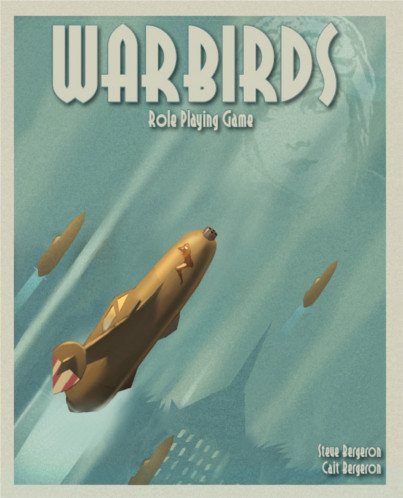
Part One: Introduction - Crimson Skies of Arcadia
Back Cover Blurb posted:
Welcome to the floating islands of Azure. Here among the dazzling fragments of the Caribbean islands is where your elite fighter pilot will make their mark on the world.
Warbirds is a game about flying and fighting for fame and fortune. Step into the role of a Guild pilot and go head to head in fast-paced aerial combat powered by Outrider Studios’ Rapidfire system. Build your fame in the air to receive opportunities to star in films, sponsor products, feature in comic books, and gain the perks of international celebrity.
For the thrill of flight and the allure of fame -- take to the skies.
Released roughly one year ago, Warbirds RPG is a neat game that I'd sum up as "Crimson Skies of Arcadia". If you're not familiar with either Crimson Skies or Skies of Arcadia, Warbirds is an fast-paced RPG set in a pulp 1930s styled alternate world where mercenary pilots do battle for fame and fortune in high-powered WW2-grade fighter planes as diesel-powered air dreadnoughts clash in the background. I bought Warbirds a few months back on Drive-Thru RPG and its been bouncing around in the back of my head ever since. I've decided to share it with the thread (Since it seems to be my fate to be attracted to obscure RPGs no one ever hears of).
I'll be going through it chapter by chapter. The book starts with a single page introductory. This page simply gives a brief overview of the setting and the player's default role in it.
In Warbirds the players are members of an elite organization of mercenary combat pilots known as The Guild. Guild pilots fly advanced combat aircraft known as Warbirds that give them a significant advantage in combat against their enemies. The Guild works to provide safety and security for its clients while making itself, and its pilots, quite rich and famous. An experienced Guild pilot isn't just a combat ace, they're a celebrity, they have fans who follow their exploits in the papers and on the cablebox, they have commercial sponsors, they get invited to all the best parties, and, of course, they risk serious public scandal if they screw up, in the cockpit or on the ground.
The introduction goes on to give a brief overview of the world of Warbirds. Azure is an assortment of floating islands amidst an endless sea of clouds, all suspended above The Murk, a layer of thick dark clouds. Azure's origins are tied to our world, in 1804 the Caribbean was struck by a super-hurricane of cataclysmic (and apparently supernatural)scale. Nearly every Caribbean island, as well as parts of Florida and the Yucatan peninsula were picked up and deposited in this new world. Each island maintains a lot of their "pre-storm" culture, but time and isolation have caused many changes. Its been over 200 years since that storm, and the world of Azure is just now reaching a technological level similar to the 1940s of the real world.
The introduction finishes up with a section on playstyle, explaining Warbirds is meant to be a cinematic action game. The players are larger-than-life heroes who risk life and limb and usually come out on top. The rules are designed to be fast-paced and capture the feel of twisting dogfights without getting bogged down in complex simulation. No tactical map is required and each player requires only a single d6. Even outside of their planes the players will be partaking in adventure as they enjoy the perks (and pains) of being Guild Pilots; attending parties, exploring new islands, dodging the paparazzi, bickering with rival guild squadrons, or even starring in movies, possibly as themselves.
Next time I'll go over Chapter 1, which covers the history of Azure, explaining its physical layout and makeup, and detailing its history from The Storm and the years of chaos and isolation following it, to the discovery of float-stone powered flight and the march towards the modern era. For now though, I'll just leave off with a 4 page comic that preceded the introductory page, the art in the book is somewhat sparse, but I rather like it.
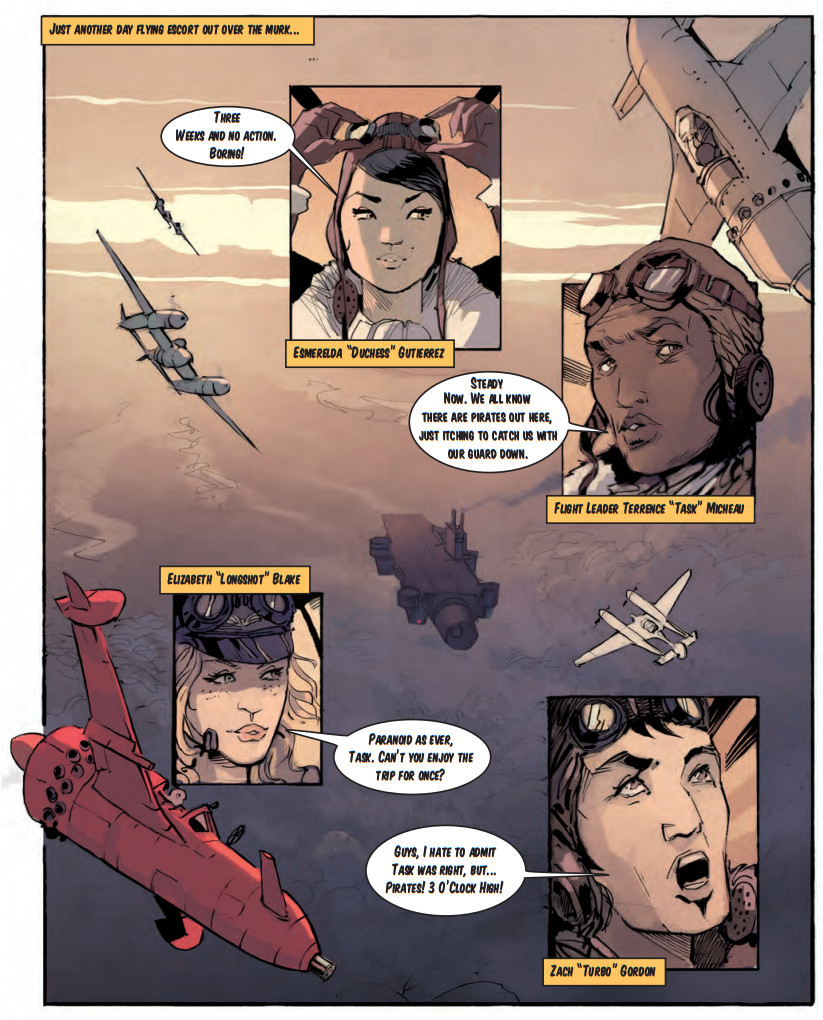
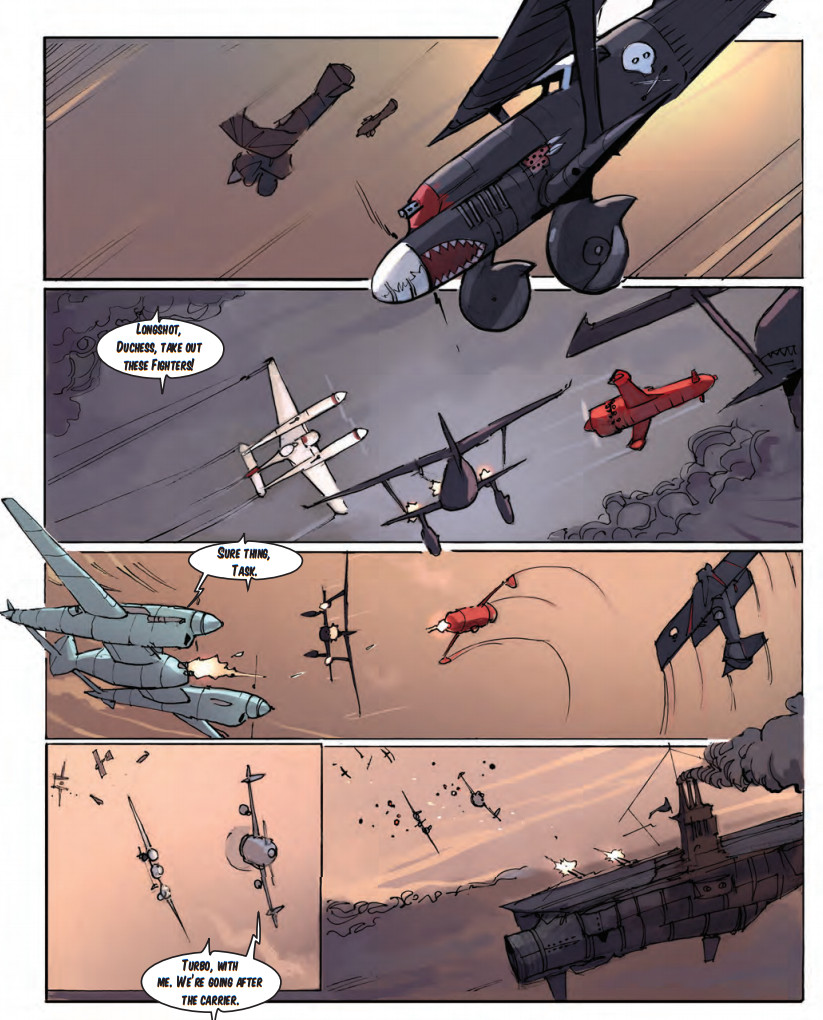
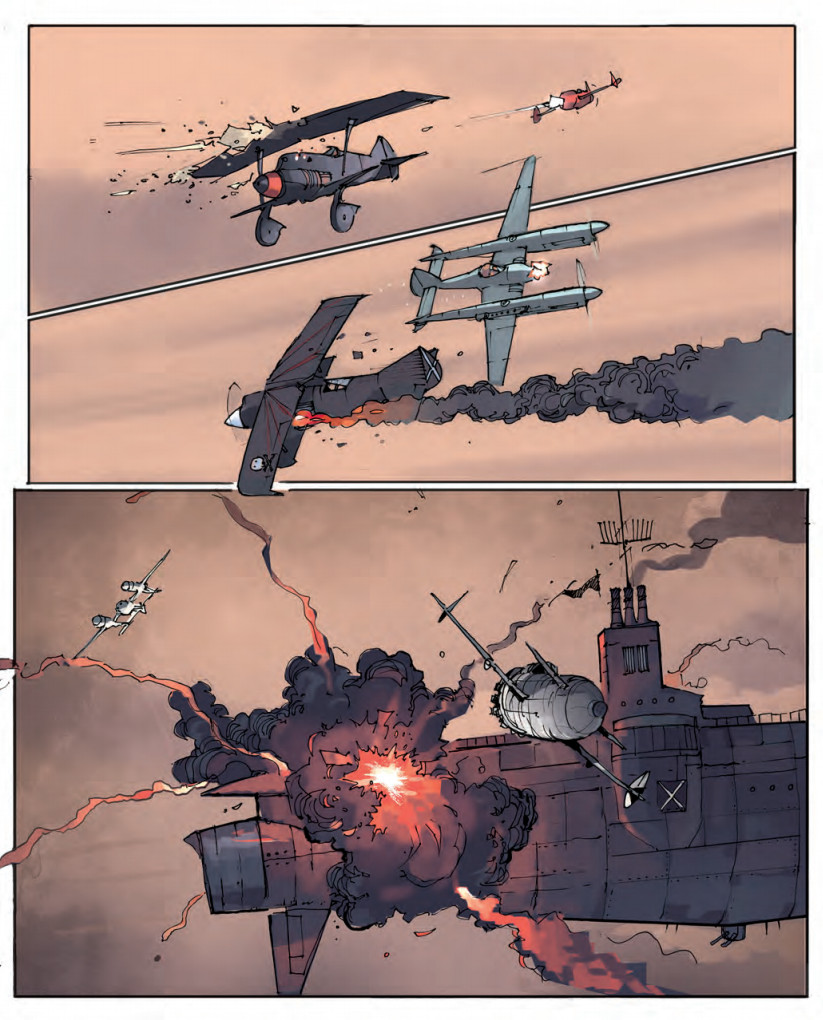
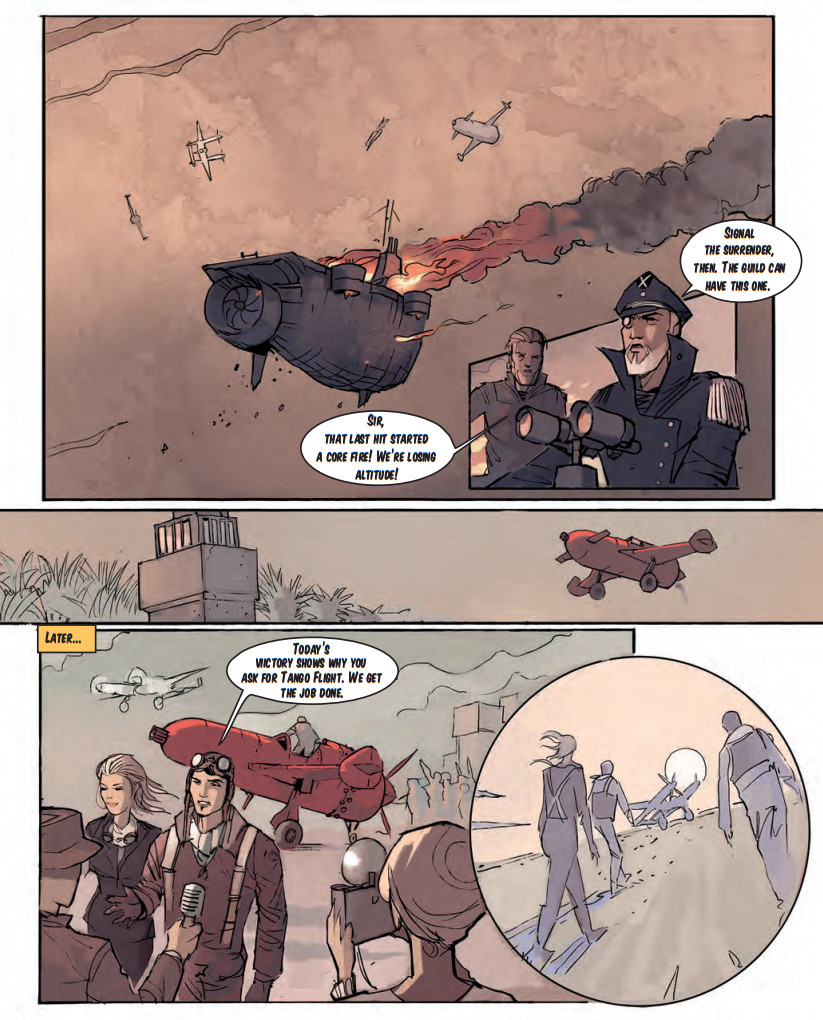
The World of Azure
Original SA post
Chapter One - Part 1: The World of Azure
The Murk
Chapter one is all about the geography and history of Azure, and as the book itself says, and discussion of Azure's Geography begins with The Murk. The Murk is an endless ocean of dark, roiling clouds beneath Azure's endless sky. The clouds of the Murk ranges from dull grey to pitch black and while it appears smooth from altitude, if you get close it actually forms "hills", spires and even arches. These features are always in a constant state of change due to the Murk's high winds, which are often in excess of 300kph. The Murk's clouds are not simple water vapor, but heavy inert gasses mixed with abrasive dust and hydrocarbons.
This makes the Murk one of the deadliest hazards in Azure, as people cannot breath in it, and aircraft engines choke and die while the high winds and abrasive dust batter aircraft and eat away at them at a frightening speed. Furthermore the atmospheric pressure rises extremely rapidly inside the Murk, your average aeroplane would be crushed before it could dive much further than a kilometer into the murk.
Of course, while a great hazard, the Murk is also a great resource for Azure, as the Murk's hydrocarbons can be mined and processed into heavy diesel fuel, a vital lifeblood for Azure's airships and airplanes which would be heavily restricted without it. Some are not satisfied to simply mine fuel from the Murk and have continued to make scientific investigations, lowering armoured "diving bells" into it. These research efforts have discovered various interesting facts, but for the most part the reality remains the same, the Murk is a deadly hazard for low flying planes.
The Sky
Rising above the proverbial bedrock of the Murk is Azure's endless skies. Azure's sky is pretty much similar to ours. A familiar sun rises and sets every day and a moon rises at night. The moon and stars don't quite match Earth's, but they're close enough. Azure's seasons are mild with winter months being only slightly cooler than the summer. Storms are semi-frequent all year, usually just rain or snow and harsh winds, though hurricane-force winds have been encountered occasionally. One big difference between Earth and Azure (besides the obvious) is that the atmosphere is cooler at low altitudes and warmer at higher altitudes.
The Eye
At the center of Azure is a massive invisible pillar called "The Eye". It is a 20km wide updraft stretching from the Murk to the top of the uplands. The constant, powerful updraft is useful for aeroplanes as they can use it to transit upwards between island layers much more efficiently.
The Eye also has several other unique features that make it the center of Azure. Most important is that all compasses in Azure point towards the eye. Navigation can be tricky, but the old standby for lost airmen is to just head eyeward and look for an island you recognize. Even without the compass Azure is quite literally centered around the Eye as all known islands in Azure rotate around it.
In addition the Eye is constantly emitting a broad-spectrum of radio noise. While strongest near the eye, this interference stretches out for thousands of kilometers. Its powerful enough to make radios useless beyond a range of about 10km. Aircraft still carry radios for obvious reasons, but commercial radio doesn't exist in Azure. Instead they have Cable, physical wires strung out to a tuner box in people's homes, think TV without the Video. Radar theory exists in Azure, but the interference of the Eye means no one has made a radar array powerful enough to really work, though the Guild puts in great effort towards figuring out a solution to the Eye's interference.
One final noteworthy property of the Eye is that floatstone doesn't work inside it. Airships, which all contain a floatstone core, begin falling as soon as they enter the eye, though their powerful engines and the natural updraft slow the descent. Any airship caught in the eye must put all power to engines and try to escape before they fall down into the Maelstrom, a swirling flurry of wrecked ships, island fragments and clouds where the Eye meets the Murk. For obvious reasons no islands pass through the eye either, as their own super massive floatstone hearts would cease working and they would plummet into Murk.
The Central Islands
Azure is primarily (as far as civilization is concerned) made up of centralized islands that consist of the Uplands, Midlands, and Lowlands. They are the home of humanity and all orbit less than 1,000km from the eye. These islands would be familiar to you and I as the various major islands of the Caribbean, and from above they would look much like themselves in the real world. However they rest in no ocean and a side view would show that their bedrock extends only a few kilometers down before coming to an abrupt, jagged end.
The Lowlands hover only about a dozen kilometers above the murk and are primarily composed of two islands, Yucatan and Tegesta. Yucatan, formerly the Yucatan Peninsula, is home to the resurgent Maya people and their collection of Federated Kingdoms. Meanwhile Tegesta, (known to us as Florida) was nearly uninhabited at the time of the storm. Just as well, for it weathered the storm poorly and it is believed much of the former peninsula broke apart and fell into the murk, leaving only the southernmost portions. Today, Tegesta is Azure's Wild West, an untamed frontier where every nation is vying for control of its resources while independent settlers are caught in between.
The lowlands are much cooler than they once were, with massive vegetation die-off leaving vast open fields ready for hardy crops. The Maya have done very well in their new environment while Tegesta now boasts some of the best farmland in Azure, too bad everyone says its theirs.
The Midlands rest about a hundred kilometers above the lowlands and are home to most of Azure's people. The major islands here are Puerto Rico, Haiti (modern-day Haiti and the Dominican republic), and Cuba. Cuba however, split in two during The Storm, one half is still known as Cuba while the other is referred to as Santiago. All of the midland nations have large populations and a shortage of resources, they import fuel and luxuries from the uplands and bring up staple commodities from the low lands. Ever hungry for resources, these nations stage frequent expeditions to errant islands to explore and exploit them.
Like the lowlands, the Midlands are cooler than they once were, but are still roughly sub-tropical. Farming conditions are reasonable, but the shortage of resources has led to mass deforestation on Cuba and aggressive strip-mining in Santiago. Regional conflicts are frequent, and Azure's first major war began here in the midlands.
The Uplands rest another hundred kilometers above the midlands and are composed of much smaller islands. Here you can find the former Lesser Antilles, the Virgin Islands, Barbados, St Vincent, Grenada, etc. You can also find whats left of the Bahamas, Trinidad, Tobago, and the Caymans. Also to be found are the two most important groups in the Uplands; the island of Jamaica, and the remnants of the Florida Keys (from Key West to Key Largo) now known as the Guild Keys, where the Fighter Guild is based out of. The largest city in Azure, and what many consider the culture capital of the world, is Kingston, the capital of Jamaica.
The Uplands environment is tropical, thanks to the typical warm and wet conditions it remains an ideal place to grow suguarcane. Once a sign of imperial hegemony it is now a major source of income for the farmers. Planes need fuel, and the majority of civilian aircraft and some light airships run on ethanol fuel distilled from processed sugarcane. The uplands have become wealthy thanks to this ethanol monopoly and are some of the freest, fairest and most comfortable countries to live in.
The Distant Isles
Further out from the Eye are thousands of island shards, most of which are the remnants of the Bahamas. A Few are in stable orbits, such as Nassau, the furthest known civilized nation, as well as the Pirate's Tangle, an unstable, foggy, three-dimensional mass of island fragments known to be home to several major pirate groups. While the Guild was first formed to combat these pirates, even they are hesitant to fly into the dangerous mess of the tangle. Other than these two, most of the Distant islands are small specks of land. Some are used as fuel stops, private retreats for the eccentric, and even hunting preserves, while others are too small to have an airstrip or even airship pier and remain uninhabited.
Beyond the Distant Isles lay the Errant Islands . Errant islands get their name from their rare and somewhat random arrivals, for they are islands that travel on long, highly elliptical orbits that spend perhaps only a few short weeks or months within sight of the Central Islands before disappearing into the endless sky for years, decades, or even centuries. The arrival of an errant island is a big deal. Several major companies exist purely to explore and exploit these islands. Some have even set up fledgling colonies on Errant islands that have been charted to come around every few years, though so far none have risked setting up a colony on an island with an orbit longer than a decade.
Floatstone
A short sidebar here explains the nature of Floatstone, the mircale material that makes Modern Azure possible. Floatstone is what keeps all the islands of Azure flying. It is a hard but brittle rock and looks and feels similar to shale. Small chunks don't seem special but feel like they've got too much inertia and fall too slowly when dropped. Larger chunks of floatstone will float and gravitate into a natural orbit, resisting efforts to be influenced. Despite this, if you take a large enough chunk of Floatstone, wrap it in steel and stick heavy diesel powered engines on it and you've got an Airship.
Floatstone has a melting point similar to heavy metals like lead. Heating floatstone weakens its floating properties, and molten floatstone has no buoyancy, but these come back once the floatstone cools and reforms into a solid. Second is that even the purest known processed floatstone still contains 20% impurities. Scientist theorize that 100% pure floatstone would rise on its own accord. How far and how fast it would rise is something nobody knows.
Getting Around
The next section covers loose guidelines for getting around the various layers. Airships take considerable time to climb or descend between island layers. In general it takes 16 hours for a civilian airship to ascend to another layer and about 9-10 hours to descend a layer. This time is halved for Military airships. If they need to descend in a real hurry, Military airships can conduct an "Emergency Drop" by intentionally heating its own Floatstone core, losing buoyancy. An emergency drop can see a Military airship falling like a brick, reaching a lower layer in less than 15 minutes, of course, the danger is getting the core cooled and functioning again before the ship hits land or the murk.
Aircraft meanwhile generally cannot ascend to a higher layer under their own power, especially the fuel hungry Warbirds of the Guild. They must rely on airships to carry them, or must use the updraft of The Eye, though they will generally still require drop tanks to make such a transit and will have to land almost immediately. Descending between layers is much simpler as they need merely glide down at a leisurely pace. Though if you're in a hurry a stepper dive can be performed. A pilot can even shut off their engine(s) to conserve fuel during the descent, though that carries the risk of being caught flatfooted.
Getting around the central islands on the same layer is a relatively simple affair, the majority of the Central islands are within 500km of the eye. An airplane can generally go anywhere in the same layer in only a couple hours. Airships are slower, but can still generally transit from one island to another within 24 hours. Heading further out is trickier, getting to Nassau, for example, requires crossing over 2,000km of open sky, well beyond the range of any fighter, and even airships will require upwards of a week to get there, even at flank speed it'd take three days. The only known airplanes that can make such a trip are the Guild's courier transports, and they will be running on fumes by landing.
Going even further to Errant islands is tougher. Few pass within less than 3,000km of the Eye and most are spotted even further out. Just locating these islands at such distances requires full-time spotter teams and exceptionally powerful telescopes. It can take airships weeks to make the journey, and there will be no promises it'll find anything useful, or even that it will be able to make a return flight if the crew have planned poorly.
Of course, getting around on the ground is a concern too. While every nation operates a variety of military and commercial airplanes and airships, most people spend their whole lives on the ground. The size of the islands combined with the rarity and expense of fuel has created a very different system of transport. Most people, especially the poor, simply walk everywhere, whether they live in the cities or the country. Bicycles are the most popular form of mechanical ground transport in Azure and even the Rich can be seen pedaling around on designer tricycles or being chauffeured in fancy rickshaws. Riding horses is still semi common in rural areas as well.
Heavy materials transport, as well as mass-transit in cities, is done via diesel-powered locomotive. These trains are, however, smaller and lighter with tracks of narrower gauge than the mighty engines we'd be more familiar with. Despite this, trains are popular, and most cities within an island are connected by train, with the largest and most affluent cities boasting passenger tram systems. Rail systems are less common in the uplands due to the smaller size of the islands, though Jamaica has a well develop rail network and the Guild has an extensive rail system linking the keys. In the lowlands, Yucatan is crisscrossed by rails that follow along the ancient Mayan Sacbe and link all the Kingdoms together. The undeveloped frontier of Tegesta, meanwhile is devoid of railroads.
Motorized vehicles such as cars and trucks, however are very rare due to the cost of fuel. Only major companies and the militaries can generally afford motor vehicles. However, Motorcycles are fast becoming a status symbol of the rich and famous, and arriving to a social event on the back of a Motorcycle is considered a fashion statement.
Next Time, the second half of Chapter 1, a Short History of Azure
Also, while looking to see if there were maps I can use instead of doing hack copy-paste jobs from my PDF, I found this video. Which basically covers what I just did much more succinctly. Am I being too wordy and not brief enough? I mean this is all fluff, so I figure being super brief might not be great here, but I've never done a F&F before.

http://www.youtube.com/watch?v=LZbJWkLfy-g
The History of Azure
Original SA post
Chapter One - Part 2: The History of Azure
The Strom
Azure’s history starts with the history of Earth. In 1804 the Caribbean sea was a bastion of European Colonialism. Cuba and Puerto Rico were major Spanish colonies while the Mayans of Central America chafed under Spanish rule. Jamaica is Britain’s largest colony in the area and grows large amounts of sugarcane and Coffee for the Empire. Other islands belong to various European powers and the economies of almost all these colonies are driven by the back-breaking labors of slavery. The only place in the Caribbean where Colonialism has waned is Haiti, who has just finished a long series of campaigns against Spanish, British and French alike to win their independence and swiftly abolished slavery.
History would’ve continued as it had in our world, if not for The Storm. On September 17th, 1804, a hurricane of never before seen scale tore through the Caribbean. With unmatched fury the storm raged for a week, turning the seas into roiling masses, smashing ships, destroying towns and spreading death and destruction to the people of the Caribbean On the 25th the clouds parted and the sun shone. Survivors crawled out of the wreckage and found the world that awaited them was not the world they previously knew. In place of the ocean they found the wide skies of Azure.
The Years of Chaos
The first few years after The Storm were incredibly harsh. Estimates calculate that roughly 25% of the Caribbean’s population perished during The Storm and the following year, and the death rate remained high for two decades. People died from famine caused by climate shifts, supply shortages of every kind and violence typically caused by the near collapse of society.
While the Caribbean and much of the rest of the world had been slowly marching towards abolition of the practice, slavery was one of the first casualties of the post-storm collapse. Much of the Caribbean’s population was made up of black slaves in 1804 and the oppressed Mayans of Yucatan fared little better. In the wake of The Storm, the wisest slave owners saw the writing on the wall and immediately renounced ownership and begged for mercy, after only a few couple years slavery was just an unhappy memory in Azure. While slavery itself was gone, other colonial influences remain. The people of Haiti speak French, while the rest of the midlands speak Spanish, English is the language of most of the uplands while the Mayans in the lowland speak their ancestral tongue.
Leaving out Yucatan, roughly half of the populace of Azure is of African or mixed ancestry, 30% are of predominantly Spanish descent, roughly 15% are of British, French, or Dutch descent, while 5% are descended from non-Mayan Natives or other more exotic origins. Yucatan however violently expelled their Spanish overlords during the years of chaos and is made up of 85% pure-blooded Mayans, with most of the rest being of mixed Mayan/Spanish origin.
As the people of Azure suffered in the years after the Storm, so too did their faith come under immense strain and strife. The majority of the Caribbean had been Catholic and once it rapidly became apparent that The Storm had not been Rapture, nor was Azure some form of heaven. Unsurprisingly, the priesthood had a tough time dealing with the many hard questions their parishes asked.
In the uplands, many simply abandoned a faith that they felt had abandoned them. Small independent churches of varying sects can still be found, but organized religion has all but vanished in the region. The uplands today are a relatively secular place.
Made up mostly of Spanish colonies the faith of the midlands stumbled but slowly recovered. Cuba eventually elected a pope and established a new Papacy that would come to be known as the Fundamental Catholic Church, today practiced by all the Midland islands except Haiti. Only three years after the Storm the isolated people of Haiti elected a new Pope of their own and conducted a significant restructuring of their Church, integrating a lot of influence from local Vodou custom leading to the Reformed Catholic Church. The two distinct Churches would inevitably come into conflict following the reestablishment of communication and travel between islands, and to this day two Catholic Popes preside in Azure and the religious squabbling continues to simmer.
Down in Yucatan however, Catholicism fared far worse. Azure’s topography was a much better fit to the ancient religion of the pre-Columbian Maya than modern Catholic teachings. The Mayan’s revolt against their Spanish overlords started as a religious one as they embraced their ancient faith, though with significantly less human sacrifice. Today Catholicism is banned in the Mayan Kingdoms.
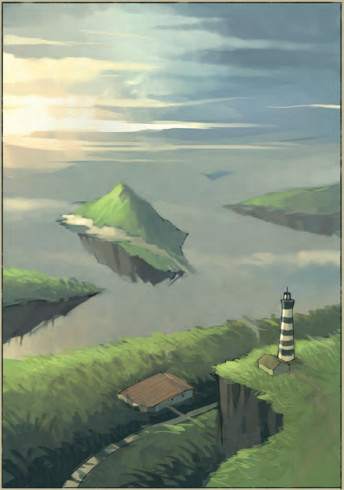
The Rise of Flight and the Golden Century
While the exact “end” of the Years of Chaos following The Storm remains debated by historians, it is well agreed upon that things were relatively stable nearly four decades later in 1843 when Puerto Rican miners stumbled upon Floatstone for the first time. It took several more years of research and development, but by 1850 the first steam-powered airships were taking flight across Azure and the people of the once isolated islands were soon brought closer together. The next few decades saw the rapid establishment of trade relations and the economies of the various islands flourished.
1883 saw the signing of an important international treaty that set many standards, including naming the new world “Azure”. The next hundred years saw the central islands thrive as populations boomed, science and technology advanced, and standards of living increased. It was during this time that scientists first discovered the chemical composition of the Murk and developed the ability to process ethanol fuel from sugarcane, leading to great strides in airship design and capabilities. By 1980 the nations of Azure had reached a point of societal and technological development roughly analogous with the turn of the 20th century on Earth. The end of the golden century saw the first advances in non-floatstone powered flight, with the first aeroplane taking its brief flight in 1975. In 1980 Jamaica was the first nation to begin the first tentative steps in adapting this new means of flying for military purposes.
The closing decades of the Golden Century were marked by military build up as each nation developed a navy of "Ironclad" armoured airships. Political and Religious tensions rose alongside military might, but the only region that saw outright warfare during the Golden Century was Yucatan, which has always featured small but intense conflicts between its many kingdoms.
The First Resource War
Azure’s peace was shattered in March, 1982 when a resource-starved Cuba launched an all-out assault on Haiti under the pretext of religious “unification”. Cuban transports landed troops during the initial assault, kicking off a five-month ground war punctuated by multiple clashes between the ironclads of both navies. The Haitians fought hard, but Cuba was quick to receive logistical support from Puerto Rico and Santiago and it seemed like the inevitable result was victory for Cuba and the Fundamental Church.
In desperation to stem the tide of the Cuban invasion, Haiti turned to Jamaica. In the years previous, while the nations of the Midlands had been building up large navies of ironclads, Jamaica with sought a more-cost effective way to counter this threat. Jamaica found its solution in the new aeroplanes being developed and poured a great deal of money into development of this new technology. By the time the Midlands Resource war had reached full swing, Jamaica had supplemented their modest navy with a hundred first-generation combat biplanes that could fly rings around any warship.
Armed with rapid-fire machineguns and light amour-piercing bombs, the Jamaican airforce destroyed nearly three quarters of the Cuban navy in a single pitched battle. The surviving ships limped back to home while Cuban troops, cut off from support, soon found themselves out of supply and on the defensive, surrendering mere weeks later. While Haiti had defeated their invaders thanks to their Jamaican allies, neither nation had the resources to go on the offensive, and so, on September 3rd, 1982, the Treaty of Havana was signed, signaling an end only major war Azure has known, though small conflicts spark every once in a while.
The Modern Era
While peace returned in the years following the Resource War, the issue of materials shortages remained. While Azure’s lands remained fertile for farming; building materials, rare elements and other luxuries were becoming increasingly scarce. The Central Islands were simply not that big and it was only a matter of time before shortages became a greater issue.
At first Tegesta seemed the obvious choice for expansion, but with every nation vying for a piece of the pie, and no one yet willing to spark a repeat of the First Resource War, no real progress could be made in that untamed region. Instead expeditions began to venture further afield, traveling to distant islands. Many expeditions came back empty handed and some never came back. However, for every failure, another expedition returned carrying a treasure trove of resources and soon the business of locating errant islands became big business indeed. One such expedition stumbled upon Nassau, which was a thriving city-state that, despite two centuries of isolation, continued to remain loyal to the English Crown.
One of the largest breakthroughs that ushered in the modern era was the development of processing the Murk’s hydrocarbons into a new fuel source. The shift away from steam and ethanol towards diesel power for airships and trains was finished within only a few years. Hydrocarbon rich “Dark Murk” is rare near the eye, causing Massive floating refinery bases to range hundreds of kilometers away from the Central Islands, with fleets of tankers ferrying the fuel back home.
It took only a few years for the first tanker to fall victim to pirates.
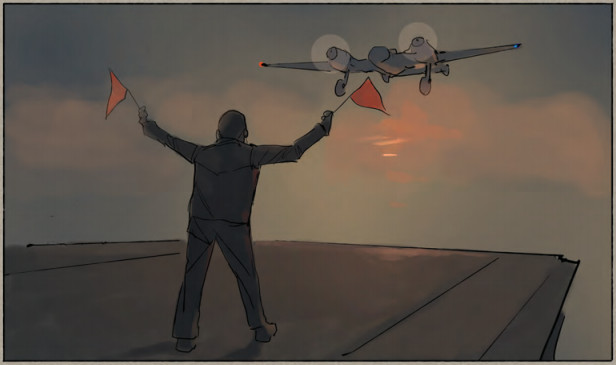
The Rise of Piracy and the Fighter Guild
As the Resource War proved, slow and stately airships are easy prey for armed aeroplanes, and it was only a matter of time before groups of criminals saw in this an opportunity to Get Rich Quick striking against fuel tankers and Errant Island Expeditions.
Thanks to hidden bases in the distant Isles, coupled with the Hijacking and even mutinies of a few early aircraft carriers, pirates were soon the scourge of Azure’s skies. The navies of Azure worked hard to contain the threat, but they had only so many ships and it was no surprise when enterprising individuals soon picked up the slack, forming the first private military companies. These mercenaries soon became a relatively cheap and easy way to protect commerce, and it wasn’t long before the most successful of these organizations coalesced into a single entity; The Guild.
The Guild soon established itself as the premier air power for any person, corporation, or government who could meet their price. Proving quite capable of making good on their promise to provide the best pilots in the best planes, The Guild soon found itself quite wealthy. This wealth was quickly and wisely invested into improving their position even further with the hiring of an entire public relations department and purchasing and rapidly developing an entire string of islands in the uplands, essentially forming their own micronation.
While each nation continues to maintain its own national forces, the Guild is infamous for poaching the best and brightest pilots from across Azure and its R&D department maintains an aggressive stranglehold on aircraft technology. Today, in 2039, it has been 50 years since the formation of The Guild, and while the aircraft of most nation’s airforces resemble the fighters of Earth’s late 1930s, the Guild’s advanced Warbirds sport technology that, in some cases, wasn’t seen until the beginning of the Earth's jet age.
The nations of Azure aren’t quite happy with this arrangement, but the Guild’s superiority can’t be denied, and with the Guild agreeing to certain restrictions and offering reasonable rates, most nations see little reason to try to change what they seemingly can’t influence.
Today Guild Pilots are treated like Sports heroes or movie stars. Kids grow up dreaming of becoming guild pilots, while adults follow their exploits in the press, fans obsess and paparazzi scrutinize. The romantic glamor is enough to make most forget that, in the end, The Guild are ultimately just a bunch of well-armed mercenaries with a tech advantage and a slick PR team.
Next Time, Chapter 2, the Nations of Azure.
The Nations of Azure (Part One)
Original SA post
Chapter 2 - The Nations of Azure (Part One)
Jamaica
Population: 1.9 Million - Climate: Tropical - Capital: Kingston - Economy: Business, arts and entertainment
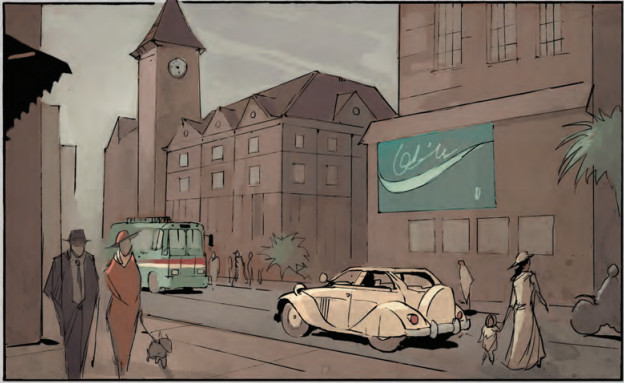
Jamaica is the cultural capital of Azure. After the storm the people of Jamaica worked hard and cooperatively to swiftly rebuild their home. Agriculture and industry benefit greatly from the advance of technology, increases in efficiency translating into increased quality of life for the populace. Jamaica reaped the benefits of its labor-saving advances, pursuing the cultural arts with zeal. By the time of the Resource War, Jamaica's growing entertainment industry included a variety of popular music styles, a phonograph record industry, comics, dime novels, and the then new motion photography cinemas. Jamaica's government is a democratic one, with an Elected Parliament and Prime Minister, though the majority of power behind Parliament rests in the hands of Jamaica's business lobbyists. Racial tensions are nearly non-existent, Jamaica is one of the few truly tolerant places in Azure.
Very little of Jamaica's economy remains dedicated to heavy industry, instead much of the island's interior is now covered in airfields, large estates, hobby farms, and trendy cities and towns. Montego Bay is Azure's "Hollywood" as a number of major motion picture companies have set up large studio lots there, and idealistic hopefuls from across Azure journey there hoping to become the next big movie star.
Over the years the capital of Kingston has grown into a thriving metropolis of skyscrapers and busy streets, its suburbia stretches across much of the south-eastern part of the island. Home to the headquarters of most major corporations, the metropolis has the grandest museums, the trendiest nightclubs and the finest restaurants. While the city is wealthy and opulent, it is not immune to the downtrodden. Kingston has its share of crime and urban poverty, and there are neighborhoods best avoided at night.
Jamaica is the island that never sleeps, and Jamaica's populace considers itself fashionable, educated, and hip. Being a Guild Pilot in Jamaica can be humbling, on most other islands people immediately take notice of a Guild Squadron's arrival on their shores. Celebrities are many in Jamaica however, and while they can still enjoy the perks of celebrity, a Guild Pilot rarely can be confident of being the coolest guy or gal in the room. Despite this, Guild pilots frequently travel to Jamaica on non-combat business, for it is here that they can record commercials, sign publicity deals, star in movies, and work on improving their public image.
The Minor Principalities
Population: 1.3 Million - Climate: Tropical - Capital: Varies - Economy: Varies
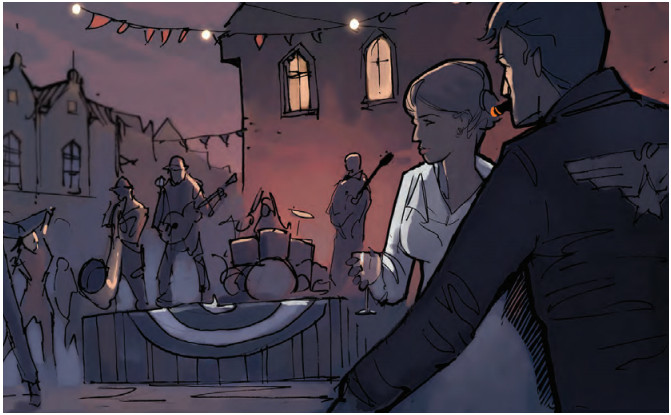
Despite the name, the Minor Principalities actually make up the majority of the Uplands. This chain of islands is home to 19 separate nations of a variety of cultures, though most are of British, French and Dutch heritage. The years after the storm were especially harsh for these islands, as they suffered greatly in the storm due to their small size and struggled to rebuild afterwards due to the same reason and lack of exploitable resources. Despite the struggles, these islands never gave up hope, their will to endure bolstered by being close enough to each other to know they were not alone, and early on some islands were even able to conduct rudimentary communications using naval semaphore.
With the advent of airship powered flight early explorers from Jamaica were quick to stumble across these islands. With the help of economic and technological aid from Jamaica, the Minor Principalities experienced a rapid revitalization into the vibrant and prosperous nations they are today. Their economy is a widely varied mixture of business, tourism, and academics, and living conditions are excellent. Thanks to its proximity to the Guild Keys, the Principalities boast several famous flight schools which attract many hopefuls, and some of the Guild's best got their start in these schools. The Principalities also feature open borders, and refugees and immigrants from other islands frequently find themselves coming here. The governments welcome these people with open arms and a variety of social and charity programs encourage and assist them in creating new lives.
During the 20th century the Principalities signed an agreement promising mutual defense, economic cooperation, and the right to govern themselves as they saw fit. The Governments of the Principalities are varied, but all relatively open democratic nations, though a few are actually business-run corporatocracies. However, thanks to relatively lax government regulation, most of the most corrupt, exploitative mining and forestry corporations operating in Tegesta have their headquarters here, while white-collar criminals take frequent advantage of the laid-back tax and financial laws. Unregulated flight schools are also a concern, churning out naive cadet pilots who have little skill but large debts. Even a few of the many charities are not completely innocent as some hide religious or political motivations, trying to force their doctrines on the less fortunate.
The Guild Keys
Population: 120,000 - Climate: Tropical - Capital: Cayo Hueso - Economy: Guild Services, Tourism
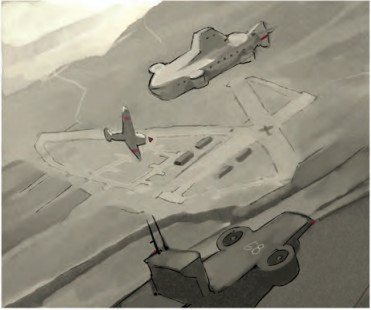
The Guild Keys are chain of islands stretching over 200 kilometers. The largest 43 islands are linked together by rail bridges made with float-stone pilings, the longest of which stretches 11 kilometers and considered a marvel of modern engineering. The Keys are owned completely by the Guild and all who live there are either Guild Employees or leasing space.
The Culture of the Keys is a melting pot as The Guild hires the best and brightest from across Azure. However in the culture of the Keys, the Pilot is king. Celebrations or are held every time the Guild hires a new crop of recruits or a Pilot achieves Elite Ace status, and days of mourning are held whenever one of these Elite Aces die. Besides its mercenary services, the Guild was quick to realize the profit potential of tourism and Cayo Hueso, the “capital island”, is home to many resorts, casinos, nightclubs, and hotels. However much of the Guild Keys is restricted to outsiders, as the island chain is studded with airfields, research labs, and assorted military facilities. The largest of these is Boca Chico bay, the Central Headquarters and command facility of The Guild.
Despite the high standards of living and ritzy nightlife, The Guild Keys are not a democratic nation. The Guild’s member squadrons elect a single Governor who manages the island on their behalf until retirement or replacement. To date all Governors have been former combat pilots. Occasionally the other nations of Azure have protested the “benign dictatorship” and made calls for reform and democracy. The Guild simply responds by holding a referendum amongst the populace. Whether due to gratitude or conspiracy, these referendum have always voiced overwhelming approval for the Guild’s continued leadership.
The Guild Keys' political policy is officially one of strict neutrality, as the Guild needs to be able to work with every nation. However behind closed doors The Guild will covertly support any action that inhibits Santiago, and will maintain this clandestine policy until Santiago begins accepting Guild Contacts again. The Guild also, of course, actively discourages the other nations from building up their air forces with assurances that the Guild can provide all the quality fighter support they need at a low cost.
The Republic of Haiti
Population: 9 Million - Climate: Sub-Tropical - Capital: Port-au-Prince - Economy: Industrial, Agricultural
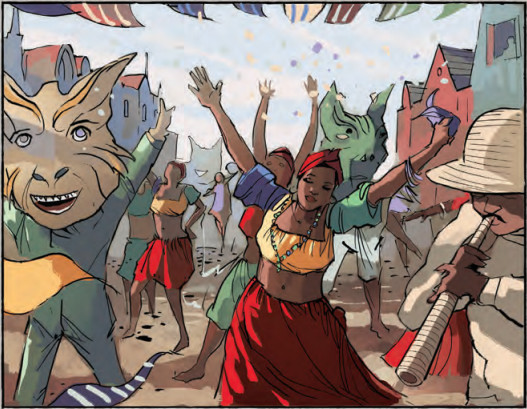
Haiti is unique in that it achieved independence and abolished Slavery before The Storm. Haiti suffered in the early years of chaos, but not nearly as bad as much of the Midlands. Its swift revival was due in no small part to the reformation of its Catholic faith creating a unifying force. In fact it was this rapid recovery and will for unification that lead to one of Azure’s first wars only 15 years after the Storm. Originally Haiti comprised only a third of the island of Hispaniola, while the nation of Dominica remained under the rule of the remnants of French Colonialism. After a brief and victorious war, Haiti unified Hispaniola under its banner and continues to rule the whole island to this day, though not without some trouble. Even two centuries later, some continue to cling to the memories of Dominica, seeking independence, with the most radical and militant of revolutionaries taking up hiding in the mountainous interior. Haiti considers these militants terrorists, and their actions have convinced many the label is apt.
Haiti has many visible signs of its French-ruled origins, including food, language and law, though these have all thoroughly mixed with its shared African heritage. Its people are staunch Reformation Catholics, but vodou rituals are also frequently observed, or at least respected. Haiti is well known in Azure for its colorful art, music, dance, cuisine, and the annual festival of Carnival is one of the biggest tourist draws in the world. Haiti is also the origin of cable, a development of its people’s wish to share music amongst themselves, and many of azure’s best musicians are of Haitian origin. Haiti is also home to L’academie International, widely considered to be Azure’s finest university.
Politically, Haiti is a stable parliamentary democracy with an elected president. Haiti has strong, friendly relations with Jamaica and the other Upland nations, while feelings with its fellow midland nations are much more bitter. The Resource War was only fifty years ago, and Haiti’s people still remember the pain of Cuba aggression and the hands of Puerto Rico and Santiago supporting them. Despite this Haiti trades openly with Cuba and Puerto Rico, but has strict embargoes against direct commerce with the Dictatorship of Santiago. Haiti is also one of the most active nations in exploiting the frontier of Tegesta, as its manufacturing sector is always hungry for resources and the majority of the island's forests have been logged to provide farmland or fuel its industries.
Cuba
Population: 6 Million - Climate: Sub-Tropical - Capital: Havana - Economy: Industrial, Agricultural
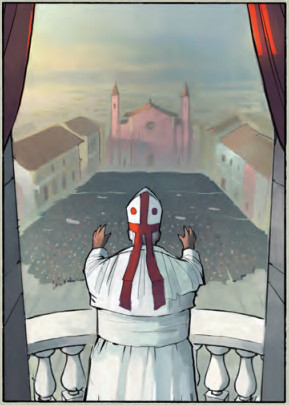
The population of Cuba was devastated during the storm when the island was sundered in two. Thousands died and nearly the entirety of Havana was destroyed. Those who survived questioned why God had abandoned them, and the people of Cuba fell into hopelessness and disarray.
After 15 years of the Cuban people’s will to endure ebbing away, a miracle occurred. A young man named Salvador Vega of Havana declared that the angel Gabriel had appeared before him stating that he had been chosen by God to rebuild the Catholic Church in Cuba. Vega declared himself Pope Julius IV and began spreading his message across the island. Though some were skeptical, most eagerly accepted him, desperate for a leader to bring them back from the brink of despair. Pope Julius IV declared the Cathedral of Havana, one of the few buildings in the city to survive The Storm, his Vatican and inspired his flock to rebuild their nation.
Today Catholicism is the center of Cuba’s culture and its national identity. Its people are extremely pious and proud of their Spanish culture, generally considered one of the happiest, most outgoing populations in Azure. However, the early discovery of Haiti’s own Reformed Catholic Church is an exception to this. To the people of Cuba, the Haitians are traitors to the faith and this resentment has become a bitter feud that helped spark the First Resource War.
Economically Banking has become the most important business in Cuba, with most of Azure’s most wealthy banks operating out of Havana. Other major industries include wine, tobacco, and other luxuries. Politically, Cuba is ruled by the Vatican, the Current pope, Pope Innocent XIV, is head of the Havana council, a 13-member oligarchy made up of high-ranking cardinals, banking magnates, and the chairs of high-profile Catholic hospitals or schools. The council is appointed by the Pope and all positions are held by men, as Pope Julius IV set up the council to reflect the apostles of Christ. Women are barred from holding position on the council, but hold positions in a secondary council of nuns and women-run charities, however this group has little real power.
Cuba’s critics state that Cuba is oppressing its people through religion and absolute rulers while offering nothing but bread and circuses in return. Most Cubans politely respond that if they didn’t like the status quo, they would change it, and indeed it seems the population is content to follow their spiritual sovereigns.
Santiago
Population: 4 Million - Climate: Sub-Tropical - Capital: Santiago - Economy: Mining, Agriculture
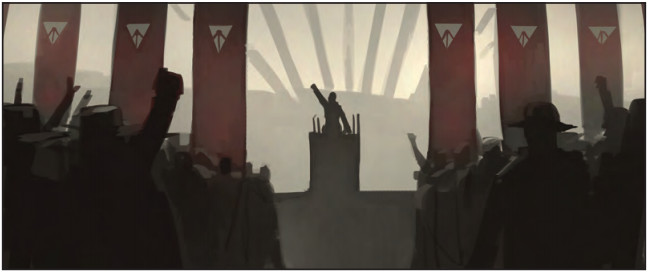
What was once the eastern half of the island of Cuba is now Azure’s most oppressive and brutal fascist dictatorship. Culturally similar to Cuba in its Spanish routes, the nation rebuilt itself following the Storm as a republic built on American democratic principles. In 1883, Carlos Murchado, a right-wing landowner, was elected president on a populist platform. While winning multiple elections, he enacted policy change that eroded the republican system, leaving himself President for Life. His eldest son took the reigns when he died and the Murchado family rules to this day, and their hold on power is stronger than ever.
Santiago is a harsh police state and culture is stagnant. Movies, comic books, and even some pieces of literature and genres of music are banned. Fundamental Catholicism is the state religion, and while the church doesn’t necessarily approve of the dictatorship, it does little to stop them, as Priests who speak up tend to disappear quickly. However the state’s attempt to control its people’s lives fuels an underground counter-culture and flares up about once a generation into open revolt. The last major revolt was brutally suppressed about 30 years ago, and today the nation is a pressure cooker due to blow once again.
The Murchados have created a cult of personality around themselves that approaches mythic status. The current President For Life is Carlos Murchado III and he is a charming, well-spoken, but ruthless man in his early thirties. Unlike his forebearers, he harbors a deep resentment for the Fighter Guild and has barred the Guild’s members and agents from entering the country.
Besides his open hatred of the guild, Carlos works hard to downplay the brutal nature of his country, making frequent diplomatic trips to Cuba, Puerto Rico, Yucatan, and even some of the Uplands. Santiago also maintains its wealth and favor with the other nations by providing them with cheaply mined floatstone, as Santiago apparently boasts more floatstone within its bedrock than other nations. Some scientist however, worry the aggressive strip mining of this vital material could lead to parts of the island collapsing and falling.
Next Time: Puerto Rico, the Lowlands, and Nassau, because this post has gone on long enough!
The Nations of Azure (Part Two)
Original SA post
Chapter 2 - The Nations of Azure (Part Two)
Puerto Rico
Population: 1.8 Million - Climate: Sub-Tropical - Capital: Santiago - Economy: Shipyards, News Services
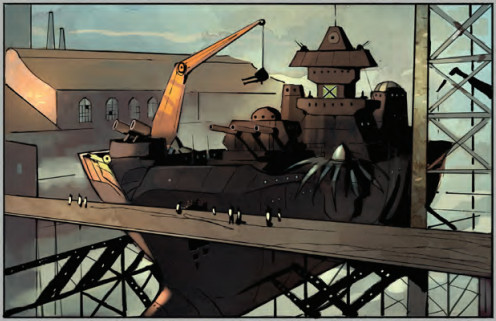
The smallest nation in the Midlands is the often-overlooked Puerto Rico. Puerto Rico is famous for being the nation that built the first airships and traveled among the skies, and that tradition continues today as it is home to Azure’s largest shipyards. These yards build new commercial and even military airships for every nation in Azure. However, these days the island is poor in resources and imports vast quantities of steel, copper, other building materials and even floatstone. These shipyards mean that Puerto Rico operates more shipping companies than any nation in Azure and it is also home to Azure’s only luxury cruise line.
While Puerto Rico shares Cuba and Santiago’s Spanish Colonial roots, the nation is far more democratic and pro-capitalist than its brothers. The attitude of its people is the closest Azure has to the concept we know as “The American Dream”, where hard work and the accruing wealth are held has high virtues. While most Puerto Ricans are Fundamentalist Catholics, they lack the deep, almost fanatical devotions of the Cubans. They supported Cuba during the First Resource War, but this support was relatively minor and half-hearted. As capitalism takes deeper root in the nation, the ideals of the almighty dollar slowly overtake God’s worship.
Strong laws protecting freedom of press have helped to keep Puerto Rico a free and democratic nation, indeed, the island is home to the “Prensa Libre”, Azure’s largest newswire. The government is made up of elected regional representatives who nominate a chancellor from amongst themselves. Peurto Rico’s shipyard and shipping based economy means the nations requires friendly relations with all nations. Generally its diplomats manages to maintain these good relations, though occasionally overeager Pensa Libre reporters can cause minor political incidents, typically in Yucatan, Santiago, or Tegesta.
Tegesta
Population: 400,000 - Climate: Temperate - Capital: San Nicolas (de facto) - Economy: Resource extraction and ranching
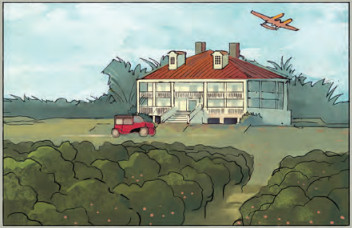
Tegesta is the untamed frontier of the Central Islands, whose coastlines are studded with rough and tumble towns, corporate holdings, and plantation homesteads large and small. The majority of the interior however remains a thick brushland home to some of Azure’s deadliest creatures, and many a headstrong explorer has disappeared into this wilderness never to be heard from again.
The people of Tegesta are a varied lot, while there are some people in San Nicolas descended from pre-storm Tegestans, the vast majority of frontierspeople are hardy souls searching to escape troubled pasts, bolster their corporation’s wealth, or simply carve a new life for themselves. One theme runs common in all who come to Tegesta however: they wish to answer to no one.
No central government exists in Tegesta, and while most towns have some form of municipal leadership and order, they typically have lax ethical and moral codes. What laws exist, however, are backed by harsh frontier justice, with punishments typically ranging from banishment to outright public execution.
With no government regulation or oversight holding them back, plantation owners are free to lay claim to vast tracts of land and use whatever unsavoury labour practices they wish. Corporations, meanwhile, take advantage of the same situation to engage in non-sustainable resource extraction methods that leave large areas devastated and barren. However many corporations soon find themselves cursing thatsame lack of government, as while there is no one to regulate them, there is also no one to protect them against Pirates and Corporate Rivals.
Yucatan
Population: 14 million - Climate: Temperate - Capital: Chichen-Itza - Economy: Large-scale Agriculture
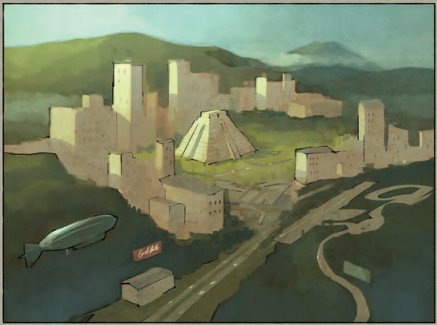
While the former Yucatan peninsula weathered the storm with only light damage, the rapid climate shift caused its own disaster in the form of massive vegetation die-off and widespread famine. During these harsh times, the oppressed Mayans turned on their former Spanish masters and cast them out of the island, literally. Hundreds of Spanish colonials were rounded up and given to the murk; pitched into the Yucatan’s many sinkholes.
As the dying jungles rotted away they revealed dozens of ancient Mayan cities and structures, which the now free people began to rebuild and expand. As they did with the cities of their ancestors, the Mayans revitalized their old religion and social structures. Today, Mayan Society is a caste structure, lead by the ruling and religious castes; below them are the soldiers, engineers, and tradespeople; and at the bottom are the farmers and other peasants. Climbing the social ladder is difficult but not impossible, and the most common method is to join the military, though many peasants are unable to endure the brutal selection processes.
Each city in Yucatan is its own Kingdom, and while the various cities are officially members of a single federation, politics on the island are quite complex. Representatives from every kingdom hold congress in Chichen-Itza, the largest city, to decide on matters of foreign policy, and it is this congress and its byzantine bureaucracy that outsiders must first wade through if they wish to do business with any member kingdom.
While the Kingdoms put on a strong appearance of unity, the well known truth is that Yucatan is frequently at war with itself. For the Mayans, war is not the familiar total war of Earth, but a more focused and ritualized war with specific objectives, rules of engagement and duration. Wars in Yucatan may only involve the soldier caste, may never target cities and towns, and can last only a maximum of 260 days. While these rules limit their destructiveness, it also means warfare is a frequently used solution to disputes ranging from territory and resource rights, to personal grudges and insults. However it is also thanks to this state of constant limited war that Yucatan boasts the most experienced military in Azure
Nassau
Population: 180,000 - Climate: Subtropical - Capital: Nassau - Economy: Business and tourism
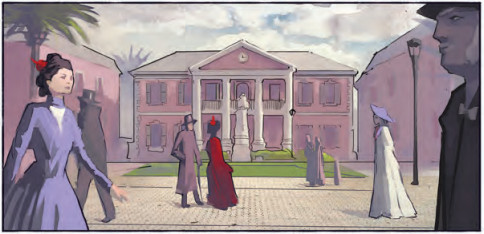
The Bahamian island chain was nearly utterly destroyed in The Storm, with most of its remnants forming the Pirate’s Tangle, however one major island survived, and on that island was the British colonial city of Nassau. After the storm, the people of Nassau were utterly alone, unable to see any other islands. Shortly after The Storm, Governor Charles Cameron delivered a famous speech, stating that Nassau was “alone in our struggle. Abandoned by God and removed from our King, we must go forward." And go forward they did. The citizens of Nassau picked up the pieces of their lives, adapted to circumstances as best they could, kept calm, and carried on.
(Sorry, couldn’t resist)
Today, Nassau is a city-state frozen in time. Prior to the island's discovery by a Jamaican explorer in 1985, Nassau’s culture, fashion, architecture, religion and customs had remained virtually unchanged since 1804. The people of Nassau were overjoyed to know they were not alone, considering themselves saved, and with the help of Jamaican supplies and technology, began the slow and difficult process of modernizing. This process is still far from complete and today Nassau is a popular tourist destination as a “living museum”.
Even today the people of Nassau consider themselves British, claiming loyalty to the crown despite not knowing who the current monarch is. A vocal minority of the populace, however, campaigns for the abolition of the city governship and the establishment of a democratic parliament modeled on Azure’s other free nations. Most citizens, with scornful politeness, consider them misguided traitors to the crown.
Due to the city-states proximity to the Pirate’s tangle, The Guild maintains (with Nassau’s blessing) a permanent outpost and airfield at Fort Charlotte, on the outskirts of the city. Another colonial fort, Fort Fincastle, is home to the city’s military police as well as a branch of Errant Observation’s Inc, who take advantage of Nassau’s distance from the Central Islands to search for errant islands.
Next Time - The last of the big fluff chapters: Chapter 3 Major Organizations
Major Organizations
Original SA post
Chapter 3 - Major Organizations
The Fighter Guild






Officially titled, "The Esteemed Guild of Combat Aviators", but in practice typically called "The Guild", this organization of elite mercenaries grew out of the need to protect long-haul shipping from the emerging pirate thread. The purpose of the Guild is simply to make its Pilots rich, and to expand and maintain its monopoly. While it has its ethical codes, The Guild will work for any nation or corporation that can meet their price, and will even fly on both sides of the same conflict. In order to facilitate this potential clash of interests, The Guild maintains several separate fighter squadrons which are often sporting rivals and willing to face one another.
Guild Warbirds comprise only ~5% of the combat aircraft in Azure, however they are responsible for ~40% of all air-to-air kills. This impressive ratio is thanks to the numerous advantages Guild Pilots and their Warbirds have over the competition. This technological edge is vitally important, and the Guild puts great effort into safeguarding its edge, some technology is considered so advance and important that it is reserved only for Veteran Guild pilots who have repeatedly proved themselves.
Warbirds are legendary for their durability, which is thanks to extensive use of Titanium reinforcement. In fact, The Guild controls the only known source of Titanium in industrial quantities, as they have a permanent mining outpost on "Titan Island", an errant island that passes by each decade. In addition, the Guild possesses laminated polycarbonate technology, which they use to construct bullet resistant cockpit canopies. This protection, coupled with the durability of Warbirds translates directly into a high survival rate for Guild Pilots downed in combat, as a result these pilots survive to learn from their mistakes and correct them. The Guild understands that while Warbirds are expensive, Guild Pilots are priceless.
Endurance is not the Warbird's only advantage, their engines produce roughly 40% more horsepower than similarly sized engines and Guild weapons possess shoot faster, hit harder, and are more accurate, and thanks to the extra engine power, Guild Fighters can carry more ammo. Of course, all these high-performance systems have their price, as Guild Warbirds are definite "Hangar Queens". On average a Warbird requires upwards of ten hours of maintenance for every hour of flight time, unlike the average fighter which requires less than a third of that.
Of course, another important aspect to the Guild's superiority, though a less obvious one, is the Guild's sheer reputation. The skill of Guild Pilots and the power and toughness of their Warbirds is legend. There have been documented cases of enemy squadrons scattering into immediate retreat at the mere sight of Guild Fighters approaching, despite 3:1 odds. Even those who stay are effected, as nerves are rattled and confidence drained. The mere presence of Guild pilots on the opposite side lowering their piloting performance. In addition, non-Guild pilots on the same side as them tend to naturally gravitate towards supporting roles, thrusting the Warbirds into the spotlight where they can score the majority of skills, furthering their reputation as deadly opponents.
Pirates
Piracy in Azure developed as a result of the long-haul nature of shipping wealth back from the Diesel Murk Refineries and the exploitation of errant islands. The first pirates were mostly disorganized groups of dissidents in stolen planes, who achieved mixed successes. Piracy got its first major shot in the arm when Santiago’s first aircraft carrier was stolen, fully loaded and equipped, by mutinous officers and organized criminals only days before its maiden voyage. With a flying base of operations, the pirates began to enjoy much greater success.
In the years since Piracy has ebbed and flowed. The formation of the Fighter Guild curtailed much of their operations, and the most successful groups fell back to the region now known as the Pirates Tangle. The tangle is what has allowed piracy to endure as a constant thorn in Azure’s side. It is a shifting mess of island fragments cloaked in a permanent fog that reduces visibility to only a few hundred meters. Planes risk smashing apart at speed, and Airships can simply push many small fragments aside thanks to being slower and larger, the tangle is littered with aerial mines, chunks of tethered floatstone covered in explosives. In over 40 years, no warship from the central islands has managed to penetrate into the interior of the tangle.
Piracy’s biggest coup, however, occurred thirty years ago in 2009, when an entire Guild Squadron, the 102 White Hawks, mutinied and joined the growing pirate conglomerate. The White Hawks are the reason behind Piracy’s resurgence over the last decades, as they plan all the biggest raids, pass stolen shipping intel to other pirate groups, arranged for cooperation between the pirate conglomerate and organized crime in the central islands, and, despite the growing age of their warbirds, are the only pirates who can approach or match the Guild in quality and skill.

Mercenaries
While the Fighter Guild is the biggest name in the business, they are not the only mercenaries in Azure. Over 30 other PMCs exist that supply pilots, and sometimes ground troops, to potential customers. Mainly based out of Trinidad in the uplands, these groups are small, but often well equipped and capable, the richest PMCs even own a handful of drop-carriers. The Guild considers these groups “Wannabes” and dismisses both their pilots and aircraft out of hand. However, the Guild isn’t above snatching away promising pilots from these groups, and this is the end goal of many pilots in these organizations.
Prensa Libre
The Prensa Libre is the largest and most powerful media outlet in Azure and its reporters are (in)famous for their ability to chase down the latest scoop. It prints daily newspapers in English, French and Spanish, and its nightly news programs are cabled into thousands of homes across the islands. Headquartered in Peurto Rico, the Presna Libre maintains offices in every major nation in Azure (save Santiago), and even has a small branch office on Nassau.
Working for the Presna Libre is one of the few ways a Fighter Guild courier pilot can earn an honest living, as the company maintains contracted access to ten of the Guild’s courier pilots. Openings for this duty are rare however, and the schedule is grueling.
Errant Observations Inc.
The big business of exploiting errant islands has naturally resulted companies that exist for the purpose of find new errant islands and auction off the rights to the highest bidders. Errant Observations Inc is the largest and most successful of these companies and maintain observatories on several upland islands.
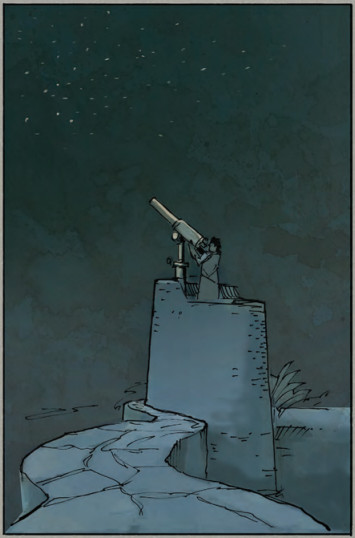
The most famous of these observatories is the one located on the furthest tip of the Guild Keys. Due to a poorly written contract and some deft lawyering, this observatory is the only land on the Keys the guild has no direct control of and the Guild has squabbled with Errant over legal issues for decades, but failed to make any ground. However, Errant’s biggest success is its exclusive contract with to search for islands from the nation of Nassau.
In addition to the observatory located there, Errant has several specially-designed high-altitude airships which it employs at Nassau. Thanks to Nassau’s remote location, the observatory and airships can locate islands over 5,000 kilometers away from the central islands.
Exploration Companies
After a new errant island is discovered, the exploration companies bid to be the first to have visiting and usage rights.The largest exploration companies are Kingston Excursions, based out of Jamaica, and Primera Vista, located in Puerto Rico, however every nation is home to at least one such company.
Once a company wins a bid, they should have exclusive rights and coordinates to an island. However industrial espionage is common and occasionally a race will begin to be the first company to set foot on the island, plant the proverbial or literal flag, and officially “claim” it under international law. These competing convoys have sparked fights and “miniature Resource Wars” have been known to occur when its not clear which company has a valid claim to an errant island.
These conflicts have yet to spill over to the Central Islands, however have been cases of national militaries sending naval forces to reinforce the claims of their citizens. Five years ago one of these incidents resulted in a standoff between Haiti and Santiago that erupted into a full-on fleet battle. While Haiti came out ahead, it was unable to draw enough resources from the island to recoup their losses in destroyed frigates, cruisers, and fighters.
The Fundamental Catholic Church
The conservative descendent of the Roman Catholic Church, the Fundamental Catholic Church maintains many pre-20th century traditions. Mass is held in Latin and largely sung, parish members are expected to observe all proper holidays, and to spread the faith.
The current pope is Pope Innocent XIV and he presides from the Cathedral of Havana, now known better as New Vatican. The papacy has defacto control of Cuba and has taken on a more active role since the First Resource War. While in the past Pope Innocent XIV has frequently employed The Guild to provide protection when he travels, recently there has been talk he wishes to create a Papal Guard to act as a personal military force independent of the guild.
The Reformed Catholic Church
After the Storm, the church in Haiti was falling out of favor compared the old local traditions of Vodou. The remaining priests and Bishops held a conference and decided the only way to survive was to elect a new pope and reform the church. The result of this is a faith today that is more in line with Earth’s Protestant Parishes than their Catholic forebearers. Reformation churches feature easy to understand services in the local-languages, they permit modern practices such as married priests, female priests, and even tolerate divorce to a degree. They are more relaxed with their approach to doctrine and tradition and even tolerating some amount of Vodou custom by their parishioners.
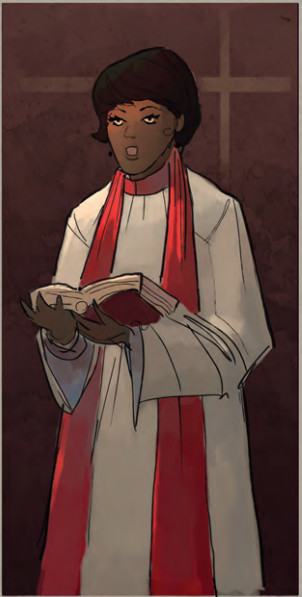
While the Fundamental Church is loathe to admit it, the Reformation Church is on the rise in Azure. In addition to its widespread following in Haiti, the Reformation Church has missionary parishes in secular nations like the uplands and Puerto Rico, a few parishes in Cuba and, surprisingly, a handful in Santiago. Currently the Reformation Church is headed by Pope Veronique, the Chruch’s first female pope, and she is a shrewd leader who knows how to spread the faith and ensure the faithful keep coming back to the pews.
Next Time - We FINALLY get to the rules! Chapter 4 “Rapidfire Rules”
Rapidfire Rules
Original SA post
Chapter 4 Part One - Rapidfire Rules
Rapidfire is a relatively simple, fast, and straightforward rules system. There are almost no reference tables, combat doesn't use a tactical map, and the math is kept very basic. All actions are resolved with a simple mechanic of 1d6 + Skill + Stat + Difficulty modifier .
Characters in Warbirds have only 3 major attributes and a few substats. The 3 primary stats are Body , Mind , and Spirit . Starting out these stats range from -2 to +2, though the actual extremes are +/-3 (representing peak human potential or a person with a nearly completely debilitating affliction). Body and Mind are fairly straight forward, though Spirit represents willpower and/or religious faith, and is also used in social situations to represent social acuity/constructiveness.
Skills are straight forward and range from 0 (untrained) to 6. There is a list of skills in the Character creation chapter, which is kept rather simple and players are free to come up with their own skills. Difficulty for rolls ranges from 2 (routine) to 14 (Epic) with the default/average being 6 and 8, leaning towards 6. Players add a penalty to the difficulty when attempting to do something they are unskilled at. Opposed rolls are, of course, a simple dice off, with the person with the higher stat (barely) winning ties. Players can help eachother when they have complimentary skills. To help a character simply makes a skill roll vs difficulty 6 and if they pass, they add a bonus to their friend's roll, with a maximum bonus of two helpers providing a bonus.
To help make those crucial rolls, players have a stockpile of points called " Reserve ". Players start off a session with a Reserve of their highest skill+2. Reserve points can be spent to add +1 to a dice roll (even after seeing the results) with a cap of +3, activate certain stunts or weapon perks in aerial combat, and a player can spend all of their remaining reserve in one go to weasel out of certain death somehow.
During player players can earn by reserve in a couple ways, first off if a player does something the GM thinks is awesome, they get +1 reserve, +1 to their roll, and an extra XP point for the associated skill. The other way is to accept a critical failure. A critical failure can occur when a player rolls a 1 and fails their target by 3 or more. At this point they may willingly upgraded their failure to a critical failure which will result in a GM-determined "Something Bad" happening to their character and they gain a Reserve Point and an XP point for the skill they use. In addition Critical Failures are supposed to be inconvenient setbacks, not lethal complications. For example, during an air battle a player might suffer a gun jam or their canopy takes a hit and spiderwebs, hampering visibility, but it shouldn't cause their wing to break off or enter a flatspin at extremely low altitude.
Fame
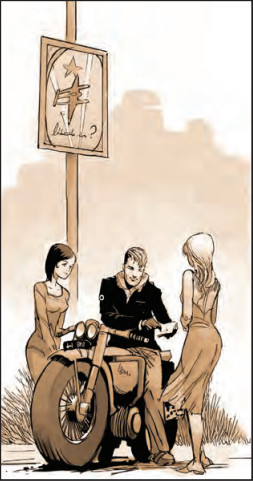
A character's Fame ranges from 0 to 6 (just like a skill) and has a few uses. It can be used to provide a once-a-session bonus to social rolls, provided the player can suitably explain how their fame works into the situation. The main use for fame however is buying stuff, as it also represents a player's income. This is covered further in the Chapters chapter. However, while fame has its uses and its in-universe perks, it also brings with some drawbacks, namely the potential to become involved in scandals. "If a character does something cowardly, stupid, needlessly destructive, or illegal the paparazzi will jump on the story and turn it into a scandal."
A player suffering from a scandal has their Fame stat turned into a penalty that applies to any of the skill rolls Fame might normally be used as a bonus towards (So mostly social stuff). In addition scandal makes it harder to buy things much harder or impossible. The Scandal penalty remains until a player finds some way (never easy) to make amends, publicly apologizes, or otherwise redeems themselves. However the book states that Scandal is never something that should be just foisted onto a player without warning, the GM should always warn the player(s) that an action their about to take will lead to Scandal.
Combat
Combat for characters on the ground introduces 3 more substats, Defense (how hard a player is to hit), Resist (damage soak), and Health. Combat is relatively straight forward. Each round combatants make an initiative roll of Mind + Awareness skill, with highest going first and working down, though combatants may hold their action to later in the round if they wish. Attacks are simply Body+Skill vs the target's Defense. Attacks deal a set amount of damage based on the weapon plus the difference between the attack and the defense roll, which is called the lead. The resist stat soaks up damage and any remainder marks off boxes on the target's health track. For example a Pistol does Lead+2 damage, so if the attack beats the defenders roll by 1, the defender takes 3 damage.
A character's health is a variable track that ranges from 1 to 10, with most people having 3-5 health. A character's health track is represented by a series of boxes with numbers in them. A person with a health of 3 looks like this: [0][-1][-1], which a massive wild gorilla (not that there are any in Azure (or are there?)) would have a health track that looks like this [0][-1][-1][-2][-2][-3][-3][-3][-3][-3]. As a character's health is marked off they begin taking a penalty to all their rolls, though the penalty is capped at -3. A character with exceptional toughness or high pain tolerance (such as an angry wild gorilla) would actually have some Injury Resistance that pushes those penalties back by a certain amount (thus the Gorilla might actually be [0][0][0][0][-1][-1][-2][-2][-3][-3], between that and his damage resist he won't even feel the first few bullets!).
A character whose health track is exactly filled in is Down But Not Out . They're in significant pain, having trouble breathing and similar effects, but they can still take actions. However every time they do take action, they must roll a d6, if it comes up a 1, the pain is too much and they pass out. A character's health track is exceeded (goes into "negatives") is Out of the Fight . They're unconcious, bleeding badly, and/or crippled. They cannot take any actions and will need to see a doctor to begin properly recovering from this.
One neat thing about Warbirds is that, as larger-than-life characters, the players (and villains!) typically cannot die unless its dramatically appropriate. They can be shot, beaten, and hit by a car, but they'll come out ok (after a hospital stay). In order to actually risk death, the player must up the stakes by voluntarily agreeing to Put Their Life on the Line . A character going all out in this fashion gains a +1 bonus to all skill rolls and their defense stat for the rest of the scene, however they're now vulnerable to horrible injury or death. A character who is take Out of the Fight will suffer some form of permanent injury (typically a disadvantage or -1 health/resist) and will outright be killed if they take double their health in damage.
Certain narrative circumstances might result in the GM forcing a character to Put Their Life on the Line, however, the GM must always give the player a warning before they a warned before the conflict begins (example, rushing into a burning building that is about to collapse). If a conflict is already in progress, the GM cannot suddenly spring a mandatory Life on the Line, even if circumstances change. However, there is an exception to this, if circumstances have resulted in the character suddenly facing Certain Death (such as being forced to bail out over the Murk, falling off a cliff, or being shot while helpless) the player must spend all their remaining reserve of die. If a player has already spent all their reserve, or have already volunteered to Put Their Life on the Line, then they simply die.
In addition to the players major NPCs are effected by these same rules, they cannot be killed unless they Put Their Lives on the Line or Face Certain Death. I especially like this rule, as reoccurring villains are a great thing, but bloodthirsty players are great at killing promising villains in the heat of the moment. In Warbirds there is a good chance the villain can survive to pester them again and, really, it just makes his eventually final demise all the more satisfying IMO. I just like the whole death mechanic cause it means that the players are not at risk of getting punked by a lucky mook with a .45 and that when the gloves come off, things will be appropriately tense.
Recovery and healing rules are pretty straight forward, and a player's wounds are usually never as bad as they originally looked. That bullet was just a graze and that stab wound missed anything vital. As long as they were not taken Out of the Fight, players recovery pretty speedily, and even gain a health point back right at the end of combat! Of course, characters that were Taken Out having a rougher time. Professional medical assistance and care is required for and healing takes longer, especially if the care is lousy or completely lacking. In addition characters that Put Their Life on the Line healer slower as this time, yeah, those injuries were pretty nasty.
The rest of the chapter's rules for ground fighters are a few pages that cover a variety of combat modifiers, special rules, environmental hazards, and a couple example fights. Some examples of this stuff are gaining a bonus to your defense by sacrificing your action, rules for disarming/grappling, what happens if you get hit by lighting, or how much it hurts to fall a ways. The Combat example is pretty decent, and comes with a little comic strip that match the action, which I'll include to finish off this post instead of more


Next Time, Chapter 4 Part Two - Rules of the Sky
Rules of the Sky
Original SA post
Chapter 4, Part 2 - Rules of the Sky
In air combat, there is only one stat a pilot has, and that is Situational Awareness (SA), and it is the foundation of all skill rolls in a fighter. A pilot's SA is the sum of their Body, Mind and Spirit stats. Pilots also have 4 skills. Piloting is used for dogfighting, pulling aerial acrobatics, and defense. Strafing is used for lining up on slow or immobile targets like Airships, trains, or buildings, while minimizing the risk from doing so. Strafing is also used in place of piloting when dogfights are "nape of the earth". Gunnery is used when shooting machineguns or light cannons while Ordnance is used when firing rockets or heavy cannons or dropping bombs.
Aircraft also have stats, and these are:
Performance representing an overall picture of speed, climb/dive rate, and turning ability.
Armour is a plane's ability to soak punishment, and is equivalent to a character's own Resist score.
Structure is an aircraft's equivalent to the Health track and functions the same way. As boxes are checked off, the pilot suffers a penalty as he has trouble getting his damaged craft to work properly.
In addition to these stats, planes have a variety of traits such as "Improved Turbo-Supercharger", "Incendiary Ammunition", "Dive Breaks", or "Gyroscopic Gunsight". These are covered later in the chapter where you create your warbird.
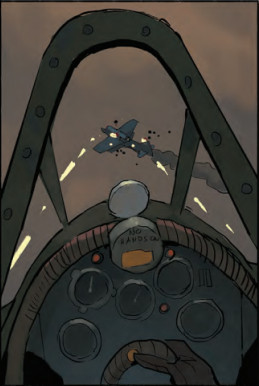
The Dogfight
Warbirds states there are no initiative rolls in dogfights. This isn't quite true. In a one-on-one dogfight (such a duel), both pilots roll 1d6 + Performance + Piloting Skill + SA and whoever comes out on top has gotten into a position where he can fire on the other. Ties go to the pilot with the higher SA, if both have the same SA, then no one gets a shot. For multi-plane engagements, you can either break it down into a series of 1v1s, or if the situation is 1v2 or 2v3 or whatever at close range, have everyone involved make Dogfighting rolls as above, then work down the line in order of highest roll to lowest (just like initiative). However, if one side outnumbers the other, the largest side get bonuses to their dogfighting rolls.
When you've got a bead on an enemy, you have two choices, you can either hold for a better shot/aim, or you can fire right away. Shooting is just 1d6 + Gunnery/Ordnance + SA + Weapon Accuracy vs the Target's Defense. Holding requires no roll and gives a bonus to shooting if you manage to win the dogfight roll next round. A pilot can gain up a larger bonus by holding for two rounds in a row if they wish. The bonus is also only good for the next attack they make against that target and then goes away (Guild light machineguns can fire twice each round).
The defender of an attack has several choices which set the level of defense the attack must beat, these options are:
Break - This is a standard turn/jink to try to avoid enemy fire and reposition. When a pilot breaks, his defense is Performance+Piloting+SA (no roll). This is called the Break Defense.
Escape - Unlike a break, this is an attempt to avoid fire by making a maneuver that will take the plane out of the fight (if only temporarily), such as making a steep, twisting dive. If a pilot chooses to attempt escape, their defense is equal to the Break Defense plus a Bonus, however the next round the pilot must attempt a Disengage action.
Shoot - During multi-plane dogfights, its possible for someone to be attacking and defending at the same time. If a pilot wishes to shoot or hold in their own turn, their defense is equal to their Break Defense minus a penalty. They also don't get to shoot until shot at, naturally.
Stunt - Pulling a stunt is a gamble and is when the a pilot attempts something drastic and unexpected. When a pilot performs a stunt, their defense is equal to 1d6+Piloting+SA. This can backfire as a poor roll will leave a plane with very low defense, however if the pilot doesn't get hit, then they get a bonus to their next dogfighting roll. A defender cannot stunt against a holding opponent, they actually have to be opening fire, and a pilot can only attempt a stunt if their plane's performance is high enough. Stunts are a great time to work that rule of awesome and be descriptive. In addition to this basic stunt, there is also a list of a few optional advanced stunts that can grant additional effects, but pilots must pay a Reserve Point to use them.

An example of the kind of thing that qualifies as a stunt (and then winning the next dogfighting roll)
When a plane does get hit, it takes damage just like a character, and suffers penalties to the pilot's skills rolls in a similar manner as its Structure track is filled. When the structure track fills up, a plane is Trailing Smoke , it can still fight, but it cannot perform stunts, and its damage is obvious to everyone (possibly drawing in kill-greedy enemies). A plane that has exceeded their Structure track is Crippled . It is too badly damaged to dogfight or strafe, and landing the plane safely will require modestly difficult piloting roll . Crippled planes automatically lose dogfight rolls, cannot stunt and suffer a steep penalty to all piloting skills (this includes the landing attempt). Most pilots tend to just nurse crippled planes back to friendly territory and then bail, rather than risk a crash landing. Finally, a plane that has suffered twice its structure in damage is Going Down . These planes are usually burning and often breaking apart in mid-air. The pilot is in all likelihood dead or busy hitting the silk.
Just like on the ground, characters can Put Their Life on the Line gaining the same bonuses. However if their plane is crippled, they themselves are injured as well. If their plane is Going Down then the pilot is unable to safely bail out and is killed. The book also notes that a plane Going Down over the Murk is a Certain Death scenario and a player character will have to spend all their reserve for chance circumstance to somehow save them.
Rounds to the Ground
As any pilot knows, dogfighting inevitably results in the gradual loss of altitude as the planes burn speed performing dives, turns and other maneuvers. Before any dogfight, the GM announces the number of rounds (typically between 1 and 10) of dogfighting planes have until they reach whatever is below them, whether it is the ground of an island of the Murk itself. When this number reaches 0, all planes must roll make a strafing roll vs a reasonably difficult number. Success means they are fine, while failure means a crash landing at best, or lawn-darting at worst.
At this point the planes must break off and climb a bit and reengage once they gain some altitude back. The longer they do this for, the more rounds they gain. Of course, if some of them wish to keep fighting then the dogfight continues with each player now using strafing for all rolls that would normally require piloting. If they roll an 8 or less, then they've screwed up and crash (And their opponent gets to claim a maneuver kill), this is a Certain Death scenario.
If at the start of a round, a pilot wishes to disengage from their opponent(s) they make a Dogfight roll as normal. If they lose, but have a better performance, they get away, but the enemy still gets to make a parting attack vs their escape defense. Aircraft of equal or lower performance must win the dogfight roll in order to escape, and a lower aircraft potentially only earns a temporary reprieve, as the pursuer can attempt to reengage via dogfight roll after a number of rounds equal to the Lead the escapee had in the disengage roll.
If the (GM determined) weather permits, a disengaged plane may simply run into the nearest cloudbank and escape from the fight completely. If there are no clouds nearby, ALL the player characters may pool together their reserve and spend several reserve points to cause a weather change that will take effect next round.
Finishing up the dogfighting chapter is a few paragraphs on Head to Heads and Ambushes. Head to heads usually only occur when both pilots agree to it and basically result in both planes shooting at eachother at the same time. Ambushes meanwhile are NASTY , a plane that fails to notice an ambush is basically an incredibly easy target and very likely going to die.
Strafing
Of course, shooting down other planes isn't all there is to air combat. Sometimes you gotta help take down an airship, attack an enemy base or take down some other kind of ground target. That is when its time to start making strafing runs.
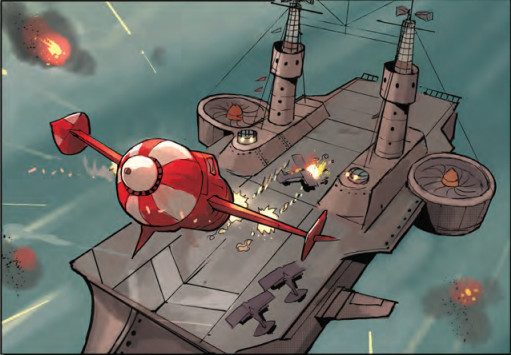
A strafing run begins similar to a dogfight. You select your target and make a similar roll, using your Strafing skill instead of your Piloting skill against a target number called The Threat . The threat is an abstract number that represents the number of guns your target has as well as how capable those guns are of tracking and hitting you as you make your attack. Similar to multi-plane dogfights, multiple planes strafing the same target in a round get a bonus to their roll as the defensive gunners split their fire. If a pilot fails their strafing run, they still get to shoot the target, but must first suffer a number of attacks equal to the margin of failure. Pilots also get the option to Cut It Close taking a penalty to their strafing roll and defense in exchange for a bonus on their attack roll, however a critical failure here will result in a crash (though such a crash may also damage the target at the GM's discretion).
The attacking plane gets to attack with both guns and ordnance and their target takes damage similarly to planes. However, not only do they usually have more structure and armor, but they actually have sub-components like Engines, gun turrets, hangars, or fuel depots. Destroying these components can damage the greater whole and typically reduces the target's threat rating.
After making their attack, fighters that succeeded in their strafing roll now suffer retaliation fire against the Break Defense (as opposed to shoot defense). Planes that failed their strafing roll and were shot at before making their own attack skip this step.
The next couple paragraphs describe what happens when a pilot decides to start strafing while he still has another fighter trying to kill him, and how ambushes effect strafing targets (its just as disastrously deadly). After that are a few closing paragraphs describing the difference in scale between people with pistols (Lead+2) and planes with heavy machineguns (also Lead+2) and what happens when they mix (*plink*! vs "Chunky Red Salsa") as well as how long it takes to refuel, rearm, and repair a Warbird. Finally the chapter closes with another couple sample combats (one for strafing and one for dogfighting), this also has a little comic.
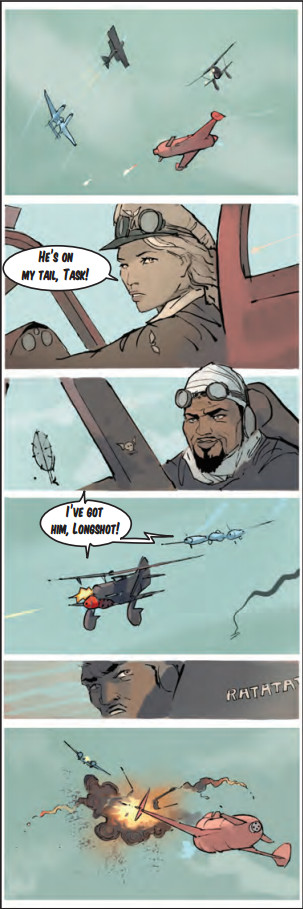
Next Time, Chapter 5 - The Characters (Character creation and advancement)
[edit] Well, its a good thing I was almost done when I hit Submit instead of Preview! :
